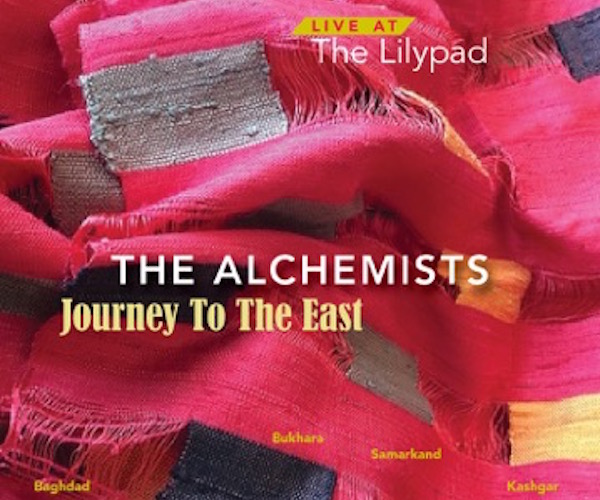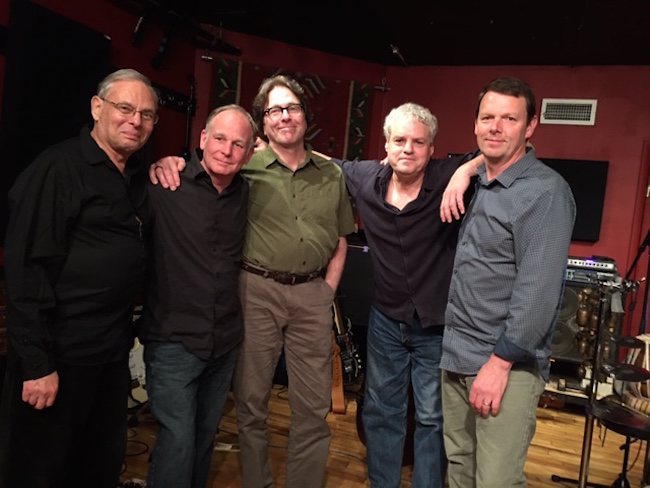Jazz CD Reviews: Freedom Now — Tetraptych’s “Tetraptych” and The Alchemists’ “Journey to the East”
If you want to know how exquisitely intuition and structure can be balanced, you could hardly do better than to hear these two new discs.

Tetraptych’s debut CD, with cover painting by Hery Paz.
By Steve Elman
In the beginning, there was melodic paraphrase. Chordal improvisation followed naturally. Modality opened the doors wider, and then there was freedom. The century-plus quest of jazz musicians to find unfettered self-expression goes on, but “free music” today is rarely completely free; contemporary players can and do use all the tools of the past to build what they want to build.
It’s been nearly six decades of synthesis since Ornette Coleman’s Free Jazz (1961) and John Coltrane’s Ascension (1965) replied to the question, “What would happen if we just play?” Those manifestos showed that musicians rooted in the jazz tradition could make identifiable jazz even without any prearranged structures, but they also prophesied that the logical end of the continuum of self-expression would be chaos.
Those who followed embraced the new language, but refused to be limited by it. Sam Rivers’s work suggested that a player could simply use whatever tools seemed right (including straight-ahead swing) to get the results he or she wanted. The Art Ensemble of Chicago, guided primarily by Roscoe Mitchell and Lester Bowie, added an arsenal of unconventional instruments, costume and drama to the tool kit. Anthony Braxton showed that composed music could sound just as free as music that was completely improvised. Keith Jarrett demonstrated that a solo concert did not need anything prearranged to be as melodic as Chopin. And Steve Lacy reminded everyone that repetition could be a tool in and of itself.
Now a million flowers bloom and freedom is just what it says it is. Listening to creative music today is an adventure that any listener can share with the players – but you have to listen with both ears. So, if you’d like to tune up your auditory nerves and learn how exquisitely intuition and structure can be balanced, you could hardly do better than to hear two new discs from some superior area players.
Tetraptych is a cooperative quartet quarterbacked by pianist Bert Seager, a veteran of the Boston scene since the ‘80s, with a shelfful of CDs to his credit. Seager’s warmth and heart infuse all of his work, and he is a natural melodist, so you might expect that this new group’s first CD, on Red Piano Records, would have aspects immediately approachable for the tender ear. And so it does. You don’t need much listening experience to hear the chords of “How Deep Is the Ocean” in Seager’s “Welcoming the Water,” and his title as well as his liner notes identify the source of “Star Wise.” But, even in the group’s free-improv “Equanimous Botch,” he sets the stage for Cuban-born saxophonist Hery Paz to slide into a free version of “Alone Together” that feels centered and sensitive. Seager provides a firm foundation for his tango entitled “Distances,” and his “Blues You Can Use” recalls Coltrane’s triple-meter modal tunes with obvious joy.
You have to admire how deftly these four musicians put flesh on the compositional bones here. Tenor player Paz admires Michael Brecker and Jan Garbarek, but he isn’t afraid to be tender, as he is on the ballad “Last Snow,” or groovy, as on “Blues You Can Use.” As a bassist must do in adventurous music like this, Max Ridley always plants his feet firmly, and he frequently seems to anticipate where Seager and Paz are going as they solo. Drummer Dor Herskovits literally shines throughout the set, with brilliant use of cymbals, razor-sharp trap work, and kaleidoscopic solos.

Tetraptych (left to right): bassist Max Ridley, saxophonist Hery Paz, pianist-composer Bert Seager, drummer Dor Herskovits.
But the members of the group create music that is much more than the sum of its parts. The handsome gatefold around the CD provides a visual parallel: saxophonist Paz, who apparently is also a gifted painter, sets off Seager’s notes with four illustrations that progress from a sketchy outline to a complete work in yellow, red, black, and green.
The music on Tetraptych’s first CD is intensely comfortable, if I can coin an oxymoron. The listener never feels as if he or she is led into dangerous territory or subjected to self-indulgent experimentation. This is music that develops the way good fiction develops. By the time you’ve ended the hour, you’ve gotten to know four real people who’ve told you six fully-realized stories.

The Alchemists neatly turn Tetraptych’s formula inside out. Instead of providing open interpretations of written tunes, this quintet offers free improvs that sound like structured compositions.
Flutist Dennis Livingston and guitarist Randy Roos are what might be called the axles of the vehicle. Livingston, son of the late Jerry Livingston (composer of “Blue and Sentimental” and “It’s the Talk of the Town,” just to name two) boasts more than two decades as a songsmith for cabaret and jazz singers, and considerable skills as an instrumentalist. Roos has been a Boston mainstay for more than forty years – he was the original guitarist in Orchestra Luna, has a long teaching career at the New England Conservatory and Berklee, and recently added recording engineer to his basket of skills.
Livingston and Roos jammed at a party with bassist Bob Nieske (faculty at NEC and Brandeis), drummer Jerry Leake (faculty at NEC and Berklee, leader of his own band Cubist, cofounder of the world music group Natraj) , and saxophonist Tom Hall (faculty at Brandeis, cofounder of Your Neighborhood Saxophone Quartet), and discovered an immediate rapport. After The Alchemists became a performing entity, Hall was replaced by New Hampshire saxophonist Matt Langley but, as the new CD shows, the band didn’t miss a beat.
Journey to the East is the group’s second CD, consisting of ten excerpts taken from their gigs at the Lilypad in Inman Square, with both Hall and Langley in the sax chair. What is immediately remarkable is how coherent each of the ten pieces sounds. In an email to me, Livingston explained that in some cases, Roos edited parts of some performances together but, for the most part, each one of the tracks unfolds as it did during the club dates, with no prearrangement. Only three of the ten end with fadeouts, another testament to the intuitive compositional sense among the players.

The Alchemists at the Lilypad, back from the exotic east (left to right): flutist Dennis Livingston, guitarist-engineer Randy Roos, bassist Bob Nieske, percussionist Jerry Leake, saxophonist Matt Langley.
Livingston titled the final tracks fancifully, weaving the abstractions of the improvs into a kind of narrative. He says, “Suppose that a group of renowned alchemists from all historical eras was summoned to late 16th century Prague by Emperor Rudolph II to engage in experiments intended to push the boundaries of the craft. Things do not go exactly as hoped.” Each of the following tracks then puts The Alchemists into a different exotic locale – Cappadocia, Samarkand, Chang’an . . . But a listener would be completely justified in making up his or her own story, or approaching the music with no program at all.
Let me take apart one of the tracks moment by moment to illustrate the band’s process: “Celebrating A Secret Palimpsest Found In The Mogao Caves of Dunhuang” opens with Langley on soprano and Livingston on flute. They lead the other players in a wide-open collective improv, but Nieske’s bass quickly establishes a fast walk and some root notes. The others coalesce around what he has suggested, and the track moves forward without a tonal center but with plenty of drive. Livingston takes the lead, with Roos and Langley providing longer lines under his flute as the rhythm percolates. Nieske and drummer Jerry Leake then switch gears, setting up a jerkier feel for a fuzzy Roos guitar solo that builds on a figure Langley has played a few moments earlier. Langley comes back in on tenor, followed by Livingston, and they gradually take precedence over Roos’s guitar. Then everyone drops out except for Langley and Roos, who play a short duet. There is a brief ensemble passage, followed by a second duet, this time between Langley and Leake. Roos establishes an ostinato under them, fills this line out with some chords a moment later, and the pattern becomes a variant on the “Love Supreme” vamp. Langley drops out and Livingston comes back in for a quiet conclusion, with Nieske bowing his bass and Leake playing little percussion instruments. All this happens in a little more than eight minutes.
Each of The Alchemists’ improvs on Journey to the East is like a circus act of music, teasing the listener with suspense about what kind of feat will come next. But, as with Tetraptych, an hour spent with this band leaves an impression that’s satisfying and sound; this is much more than just hearing great musicians being clever. Now, if only they’d get the opportunity to gig more often, you could hear them do their stuff live.
More:
Tetraptych performs on the first Wednesday of each month at the Lilypad, 1353 Cambridge Street, Inman Square, Cambridge. Next gigs: September 6, 7:30 p.m. and October 4, 7:30 p.m. They are also scheduled to play at Spice Thai Kitchen, 15 Depot Square in Ipswich, MA at 7 p.m. on November 3, November 17, December 8, and December 15.
Bert Seager’s website
Hery Paz’s Facebook page
Max Ridley’s website
The Alchemists’ Facebook page
Dennis Livingston’s website
Bob Nieske’s website
Matt Langley’s website
Steve Elman’s four decades (and counting) in New England public radio have included ten years as a jazz host in the 1970s, five years as a classical host in the 1980s, a short stint as senior producer of an arts magazine, thirteen years as assistant general manager of WBUR, and currently, on-call status as fill-in classical host on 99.5 WCRB since 2011. He was jazz and popular music editor of The Schwann Record and Tape Guides from 1973 to 1978 and wrote free-lance music and travel pieces for The Boston Globe and The Boston Phoenix from 1988 through 1991.
Tagged: Bert Seager, Dennis Livingston, Randy Roos, Red Piano Records, Tetraptych

[…] Read Steve Elman’s wonderful review of the album at http://www.artfuse.org. […]